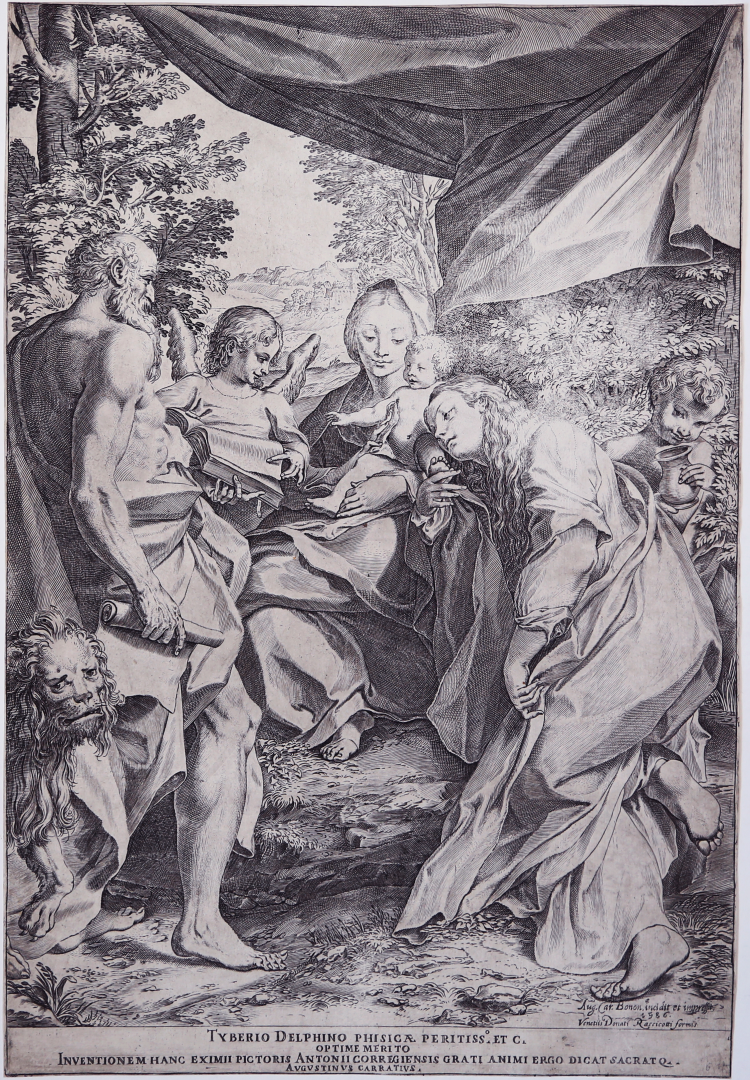



| Reference: | S30681 |
| Author | Agostino CARRACI |
| Year: | 1586 |
| Measures: | 332 x 484 mm |


| Reference: | S30681 |
| Author | Agostino CARRACI |
| Year: | 1586 |
| Measures: | 332 x 484 mm |
Etching, 1586, signed and dated in plate lower right. Example in the third state of four, with the address of Rascicotti. After Correggio.
Excellent proof, printed on contemporary laid paper, trimmed to copperplate, in excellent condition.
The engraving depicts a famous altarpiece of Correggio, as explicitly stated in the caption, painted for the chapel of the family Bergonzi, in the church of St. Anthony in Parma, now preserved in the National Art Gallery in the city.
The subject is of a mystical nature: St. Jerome, now elderly, has offered to Jesus and his translation of the Bible from Hebrew into Latin, called the Vulgate, to whom he had been waiting for years, commissioned by Pope Damasus. The figures in the composition are arranged in a semicircle, the Holy One, at whose feet the lion is represented by him healed, an angel puff volume for the Child, and the Virgin holds in her lap with Mary Magdalene is gently bent over him, and on the right another angel who watches the scene sideways, holding in his hand a pot of ointment, an attribute of the saint.
According to Malvasia, engraving by Agostino derives not from the original blade, but from the press that drew Cort, and in fact in competition with this. His theory, however, was rejected by Ostrow, first of all, not only because in 1586 Cort had been dead for eight years and therefore had no sense an artistic rivalry, but because they thought that Carracci had personally seen the blade of Correggio in Parma, during the trip that would have been right in 1586 in fact, the Cords of St. Francis and the Ecce Homo prove the presence of Augustine in its Parma between 1586 and 1587.
Looking at the two incisions and the painting, it is clear that the Cort for Carracci depends on the interpretation of the landscape in the background, the trees, the drape. We do not exclude that Augustine has actually vineyard church of St. Anthony, but no doubt he stuck to the work of Cort.
Bibliografia
Bartsch, 95; Bellori, p. 115; Le Blanc, 32; De Grazia, n. 142 III/IV; Malvasia, pp. 76, 267,270; Ostrow, 38.
Agostino CARRACI (Bologna 1557 - Parma 1602)
|
Leading figure of the “Accademia degli Incamminati”, started in Bologna by his uncle, Lodovico Carracci, Agostino supported the anti-mannerism movement. He wanted to restore the great Italian tradition of the Renaissance, referring to artists such as Titian, Raphael, Michelangelo and Correggio.
Unlike Lodovico and Annibale, who preferred paintings and frescoes, he devouted himself to engravings, which he considered more coherent with his nature, reaching a very high quality level for the brightness of his sign and his technical skills.
He visited Parma, Venice and Rome (1594) following his brother Annibale who had been hired by the Farnese family, and this helped him to enlarge his knowledge of contemporary engravings.
His catalogue of engravings includes 234 pieces, with sacred subjects, taken from the main artists of his time (Tintoretto, Barocci, his brother Annibale, Francesco Vanni and many others); profane subjects, which he particularily loved and in which it can be seen his deep love for old, classic arts.
|
Agostino CARRACI (Bologna 1557 - Parma 1602)
|
Leading figure of the “Accademia degli Incamminati”, started in Bologna by his uncle, Lodovico Carracci, Agostino supported the anti-mannerism movement. He wanted to restore the great Italian tradition of the Renaissance, referring to artists such as Titian, Raphael, Michelangelo and Correggio.
Unlike Lodovico and Annibale, who preferred paintings and frescoes, he devouted himself to engravings, which he considered more coherent with his nature, reaching a very high quality level for the brightness of his sign and his technical skills.
He visited Parma, Venice and Rome (1594) following his brother Annibale who had been hired by the Farnese family, and this helped him to enlarge his knowledge of contemporary engravings.
His catalogue of engravings includes 234 pieces, with sacred subjects, taken from the main artists of his time (Tintoretto, Barocci, his brother Annibale, Francesco Vanni and many others); profane subjects, which he particularily loved and in which it can be seen his deep love for old, classic arts.
|